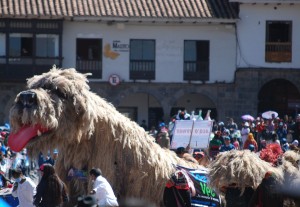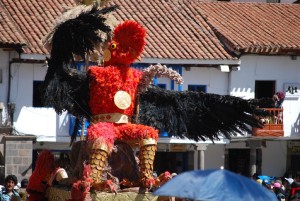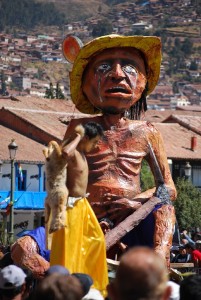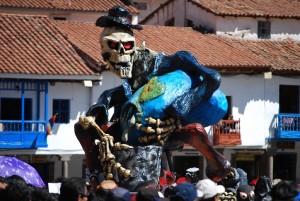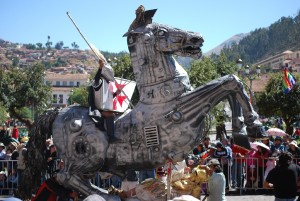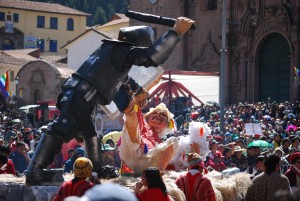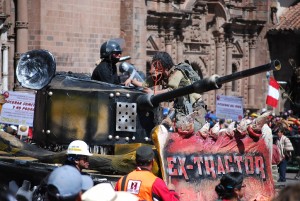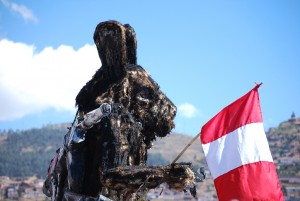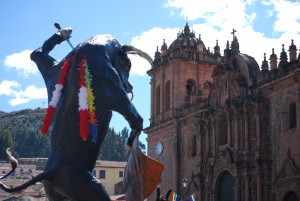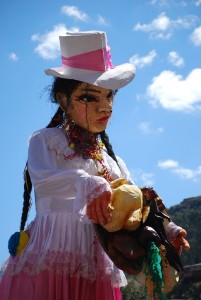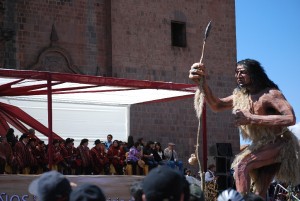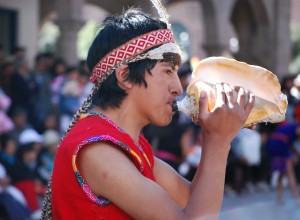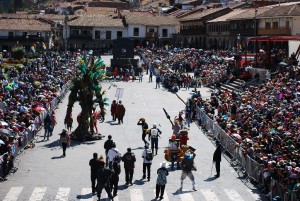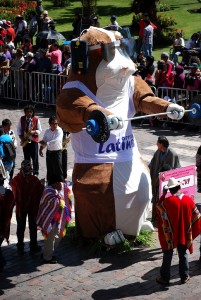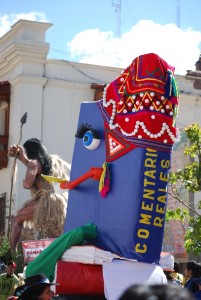Giants Take the Streets of Cuzco Today
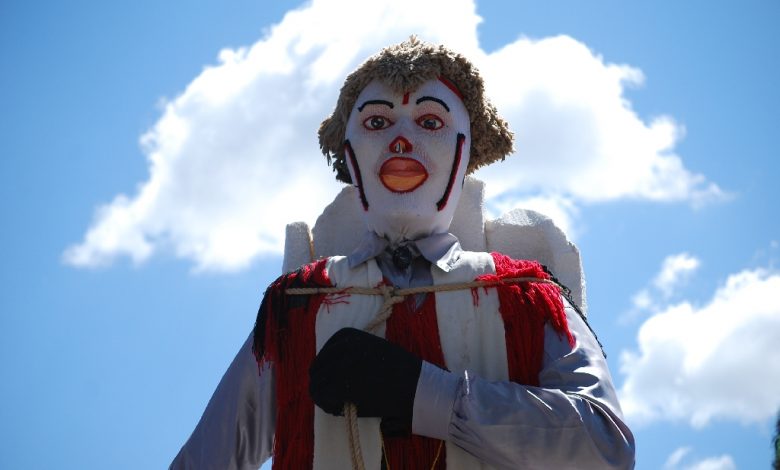
Another day, and the sun breaks through Cuzco’s murky air. Once again, the fountain in the center of the majestic plaza is surrounded by a screen of white cloth as faux rock is laid around it to make a platform for the statue of the Inca that last year made his controversial appearance during these festivities. Young women and men fill the plaza practicing for the big even, the Inti Raymi pageant, the 24th. In the meantime, at ten am giant images are expected to begin rounding the plaza.
Made by the School of Fine Arts, the giant figurines will parade for several hours. They represent different aspects of Cuzco’s social life. Not only do they represent persons, situations, and places considered typical, they may also depict political concerns and take a strong stance.
In Spanish, they say that the figures, called allegories, “satirize” the situations and persons they represent. In English, this word tends to mean “poke fun at”. For example, Wikipedia says “in satire, vices, follies, abuses, and shortcomings are held up to ridicule, ideally with the intent of shaming individuals, and society itself, into improvement.”
Here, though, the word seems more to mean represent in a stereotyped or heightened way. The word is also used to describe the relationship of dance to the people and situations it is supposed to depict. While present, humor and irony are not the dominant aspect.
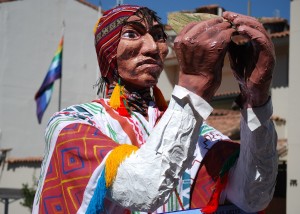
A different and older meaning of satire is “a dish filled with all kinds of fruit which is offered annually to the gods.” This definition, from the Latin, predates the use of satire as an ironic literary or theatrical genre and emphasizes two things of importance for Cuzco. The satire brings things together in ways that are seen as typical of the time or the people. And, the satire is carried out as an offering to the holy, whether the gods, or in the case of Fine Arts to the Holy city of Cuzco.

These giant allegories, what in English we would probably call floats, are part of the “greeting” to Cuzco during its annual Jubilee Month by the different institutions of the city. Some just parade, but most organize dances to show Cuzco the wealth of its Culture. The School of Fine Arts creates these giants to parade through the city.
This year, the parade comes just after a different set of giants, the saints and virgins have similarly paradedaround the plaza. In fact, as a write in a cafe on the plaza, one of these saints is making its belated exit from the Cathedral. These figures, called holy, are similarly heightened and stereotyped to represent the saint’s stories that are found in preachings and in Catholic books. In contrast the stories the figures refer to are found in ordinary experience and, sometimes, in recent press coverage.
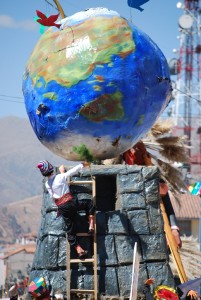
In any case, though both are larger than life and portray things that are very important to the city and region of Cuzco. When put side by side, the two presentations recreate one of the great dualisms of Western society. The procession of the 14 saints and virgins for Corpus Christi portrays the holy things that pertain to the domain of the Church as it, in turn, relates to Cuzco’s historical neighborhoods. The Artistic works from the university level School of Fine Arts stems from the secular part of the city and they meet in the plaza.
Cuzco has a very long history of fine art. Inca artists were amazing, and the tradition of art continued into the colonies when the famous Cuzco School created art that was and is much admired and repeated.
Though the tradition declined during the intervening centuries, in 1946 the School of Fine Arts was founded to remember and recreate the great tradition of fine art from the past. Located in the sumptuous mansion of the Marquez de Valleumbroso on Marquez street, the School, named after the great colonial painter Diego Quispe Tito, has had a strong impact in the city. Not only do its artists regularly contribute to art sold on the streets but to galleries such as the Fractal Dragonand the Casa Qente, as well as numerous small gallery/stores. In addition Cuzco-trained artists increasingly are gaining attention nationally as well as internationally.
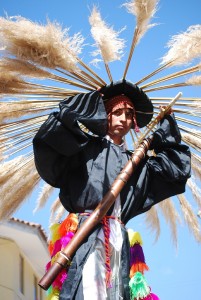
Today’s parade includes an ample supply of political positions, such as ones arguing for recycling, against the state of siege in Espinar, and against bull fighting. There is also one imagining the the apocalypse predicted for this year in popular media. There are also portrayals of Inca myths, animals, drinks and food, and a seller of chiriuchu from San Jeronimo.
Besides the giants, the schools administrators dressed up as dancers to present the classic Cuzco dance “majeño.”
A lot of fun, with parading giants, bands, and life-sized fantasy figures, today’s parade is more. It is a means for young artists to learn skills directly relevant to graphic arts and especially advertising, such as taking a reality and reducing it to its minimum while heightening the drama in it to make a point (while some of these young artists will go on to make careers as studio artists, most will work in the commercial sector as graphic artists.)
Most importantly, today’s event is a greeting to Cuzco and a ceremonial representation of important secular events to people for them to see and reflect on.
